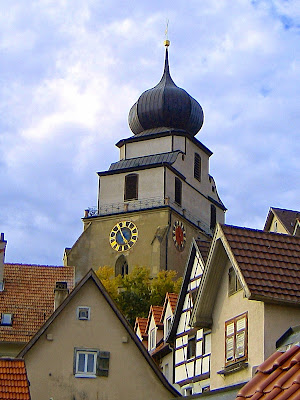What a history this place has!
In one of my many sojourns throughout Germany, I made a last-minute decision to take a tram from the city of Karlsruhe all the way up through the Black Forest to Freudenstadt, the largest city on top of the Black Forest range. The city, whose name actually means City of Joy, was founded for Huguenots (French Protestants) in 1599 by the Protestant Duke Friederich of Württemberg, who invited them to come into his domains to escape further persecution, this time by Catholics in Salzburg. This was not the first time German princes had welcomed French Huguenots who were escaping persecution and death because of their faith. The Germans had another good reason for inviting them into their domains: the Huguenots were hard workers and merchants.
 |
| Part of the market square in Freudenstadt. Unless one is in an airplane, it is very difficult to get the entire square into one shot. |
It was autumn when I visited here and I clearly recall how much cooler it was up here than down in Karlsruhe, near the banks of the Rhine River below. The city is 736m (2415 ft.) above sea level and has a population of just under 24,000. It boasts the largest market square in all of Germany, and I can tell you that if indeed there is a larger market square in the country, it must be the size of the Vatican because this is indeed huge. It appears to be perfectly square and has several dozen fountains within it.
Toward the end of World War II, the city was severely damaged - vast swathes of it were burned in a devastating fire. Interestingly, in keeping in mind the fact that its founders had already once escaped religious persecution by the French hundreds of years ago, it was Allied French forces which played a large part in its destruction in April 1945. Yet, since then, it has been meticulously restored.
Upon arrival and after my scenic tram journey up the sides of the Black Forest's mountains, I decided to find a nice café for coffee and, well, Black Forest cake, of course: that cherry and whipped-cream delight with a flavoring of espresso and cocoa. I chose a café on the expansive market place and ordered coffee to go with it, of course. There were numerous tourists who mostly seemed to be retired. The service was slow, as is often the case in Germany, but the as is often the case, the cake was worth the wait.
I think my favorite structure in the city has to be the church on one corner of the market square. It was constructed in an 'L' shape. As can be seen in the photographs below, there are two steeples, or towers, which stand at the end of each wing, with only one containing the clock faces. The reason for this interesting construction is that at the time the original church was built between 1601 and 1608, Protestant men and women were to sit separately, and by having two distinct wings, this was more easily ensured. The pulpit is directly in the middle at the angle, so the pastor had a clear view of everyone in the congregation.
As can be seen in the photograph above and below, the arcade which is part of the rest of the vast market square which this church helps to create as one of the square's corners, is part of the church itself just as it is on all of the neighboring structures.
 |
| The Stadthaus (city house) can be seen through the arcade of a house next to the Evangelical Lutheran Church |
 |
| Other side of the church: street view of the Lutheran church outside the Market Place |
 |
| One of a number of independently standing structures on the market square. Note the obligatory arcade which is on all structures which make up the perimeter of the market square of Freudenstadt |
 |
| Another angle of the Evangelical Lutheran Church and its arcade |
There are many beautiful, large homes in Freudenstadt that were built around the turn of the 19th-20th centuries. Unfortunately I don't know anyone from there, so I can't honestly tell you the history as to why they are here. I want to think that perhaps they were vacation homes used as mountain retreats in the hot summers, but the houses are particularly large for vacation homes, so maybe some were built as flats or apartments just as they are today. Whatever the case, many are certainly worth walking past to admire.
 |
| The designs on the walls of the house appealed to me. Very quaint |
 |
| Shopping and living quarters are mixed here as they are in so many other European cities. |
Getting there:
From Karlsruhe main train station the trip is about two hours. Trams run several times an hour.
From Stuttgart main train station, the train journey is about one hour 25 minutes. Trains run roughly once an hour except midday when it is twice.
See:









.JPG)

.jpg)
.jpg)



































